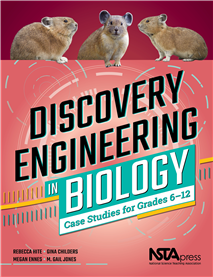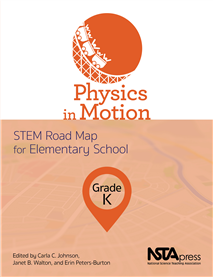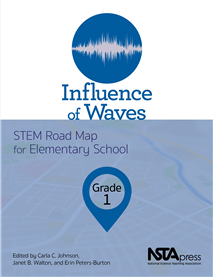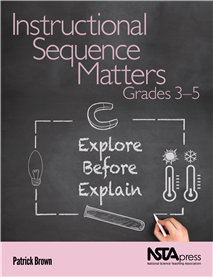All Book Chapters
Book Chapter
This chapter presents a case study on Using Sensors for Monitoring and Communication using the discovery engineering process. In this lesson, students learn about the accidental discovery of microsensors and also read about contemporary research on ...
Book Chapter
This chapter presents a case study on The Discovery of Taq Polymerase using the discovery engineering process. In this lesson, students explore the discovery and subsequent use of Taq polymerase, an enzyme from the bacteria Thermus aquaticus. After ...
Book Chapter
This chapter presents a case study on The Discovery of Vaccines using a discovery engineering process. In this lesson, students read about Dr. Edward Jenner’s use of cowpox to vaccinate people against smallpox. Students review different viral dise...
Book Chapter
This chapter presents a case study on “Y” Should Mixed-Sex Test Subjects Be Used in Medical Research? In this lesson, students explore the importance of mixed-sex animal models in preclinical research. After reading the case study, students will...
Book Chapter
This chapter presents a case study on The Accidental Discovery of DNA Fingerprinting using the discovery engineering process. In this lesson, students read about the accidental discovery of DNA fingerprinting and explore how the process has been use...
Book Chapter
Mr. Antibiotic, Tear Down This (Cell) Wall
This chapter presents a case study on The Prokaryotic Resistance of Penicillin using the discovery engineering process. In this lesson, students explore the history and discovery of penicillin which revolutionized the treatment of bacterial infectio...
Book Chapter
This chapter presents a case study on Darwin’s Observations in the Galápagos Islands using the discovery engineering process. In this lesson, students explore the observations Charles Darwin made in the Galápagos Islands. They learn about cladist...
Book Chapter
This chapter presents a case study on Using Bioprospecting to Find Cures for Disease using the discovery engineering process. In this lesson, students explore paclitaxel, a chemical in the bark of Pacific yew trees that was discovered through biopro...
Book Chapter
This chapter presents a case study on Using CRISPR to Microedit the Genome using the discovery engineering process. In this lesson, students explore the process of CRISPR, a gene-editing tool used to insert beneficial genes or delete damaging genes ...
Book Chapter
Let’s Explore Motion Through Play!
In this lesson, students are introduced to the module challenge and begin to explore the concept of physics in motion through everyday play experiences. They make predictions about the motion of toys and participate in Physics in Motion Game Days, du...
Book Chapter
In this lesson, students explore the concept of physics in motion by exploring roller coasters and working in teams to create virtual roller coasters. The focus is on forces that act on roller coasters. We recommend reading Chapter 3, which is includ...
Book Chapter
Roller Coaster Design Challenge
In this lesson, students work in teams to use the engineering design process (EDP). They apply their learning from previous lessons to design, build, and test various marble track roller coasters. We recommend reading Chapter 3, which is included in...
Book Chapter
This lesson introduces waves as traveling disturbances that move through space and substances to transfer energy. Students explore the concept of waves through interactive read-alouds, a video, and an inquiry activity in which they explore waves in w...
Book Chapter
In this lesson, students explore the concept of sound through interactive read-alouds, videos, and inquiry activities. They create a simple communication device to investigate the role of sound in communicating over distances. Students also learn the...
Book Chapter
In this lesson, students explore the concept of light through interactive read-alouds, viewing videos, and an inquiry activity in which they investigate how light interacts with various materials. We recommend reading Chapter 3, which is included in ...
Book Chapter
In this lesson, students synthesize their learning from the previous lessons to address the module challenge. They demonstrate their learning about light and sound waves by creating a musical performance that incorporates light. Students also use the...
Book Chapter
Rethinking Development and Learning
This chapter starts with the research on learning and cognition. It takes you through some of the emerging ideas about students’ intellectual abilities in terms of developmental psychology, neuroscience, and cognitive science research and the impli...
Book Chapter
Connecting Hands-On With Minds-On Experiences
This chapter shows why the exact placement of activities in instruction is pivotal in learning and compares two different hands-on approaches. Assertions are provided about why “explore-before-explain” teaching is beneficial for learners with abu...
Book Chapter
Modern Sequences of Instruction
This chapter discusses the key components of two contemporary sequences of science instruction. You will read about the phases of the Predict, Observe, and Explain (POE) and 5E instructional models. The activity boxes included are aimed at helping yo...
Book Chapter
Content and Process Working Together
This chapter describes the construction of the Next Generation Science Standards (NGSS). Some activities are shared to reflect on the lessons you currently use and the connections to components of the NGSS. The activity box included is meant to provi...
Book Chapter
This chapter provides guidance on how you can create 5Es that translate the Next Generation Science Standards (NGSS). Activities are presented following each factor that you should consider when planning 5Es and offer some planning ideas to design �...
Book Chapter
Teaching About Heat and Temperature Using an Investigative Demonstration
Chapters 6–13 share grades 3–5 model lessons for putting the “explore-before-explain” mind-set into practice. This chapter can be used as a starting point for eliciting elementary teachers’ views of the effective sequencing of science instr...
Book Chapter
Investigating Change Using the Invisible Test Tube Demonstration
Chapters 6–13 share grades 3–5 model lessons for putting the “explore-before-explain” mind-set into practice. In this chapter, the model lesson is aimed at explaining why objects appear different underwater versus out in the open. The lesson ...
Book Chapter
There’s More to Magnetism Than Objects Being Attracted to Refrigerators
Chapters 6–13 share grades 3–5 model lessons for putting the “explore-before-explain” mind-set into practice. This chapter explores a phenomenon related to the lesson title and begins with an engagement activity that uses formative assessment...
Book Chapter
Making the Connections: Addressing Students’ Misconceptions of Circuits
Chapters 6–13 share grades 3–5 model lessons for putting the “explore-before-explain” mind-set into practice. In this chapter, elementary students explore phenomena related to understanding the question “Why do the lights turn on when we fl...
Book Chapter
Chapters 6–13 share grades 3–5 model lessons for putting the “explore-before-explain” mind-set into practice. This chapter offers a 5E lesson with Elaborate and Evaluate phases that places students in the role of scientist and asks them to ca...
Book Chapter
Chapters 6–13 share grades 3–5 model lessons for putting the “explore-before-explain” mind-set into practice. This lesson is one step in helping students develop an understanding of the conservation of matter that takes place during a chemica...
Book Chapter
A Natural Storyline for Learning About Ecosystems
Chapters 6–13 share grades 3–5 model lessons for putting the “explore-before-explain” mind-set into practice. In this chapter, the third-grade lesson is aimed at developing students’ ideas about living things and Earth’s systems. The less...
Book Chapter
The Grand Erosion Investigation
Chapters 6–13 share grades 3–5 model lessons for putting the “explore-before-explain” mind-set into practice. In this chapter, the fourth-grade lesson is aimed at helping students explore the Next Generation Science Standards (NGSS) performan...
Book Chapter
Leadership and Lessons Learned
This chapter takes you through five key points for putting an “explore-before-explain” mind-set into practice using Predict, Observe, and Explain (POE) and 5E sequences, as well as the Next Generation Science Standards (NGSS). This final chapter...
Book Chapter
Science and Religion as Part of Our Professional Responsibilities
In this first chapter, we make the argument that addressing science and religion is, in fact, part of our collective job. We review four domains of science teaching to make our case and to assist you in explaining, justifying, and defending your choi...
Book Chapter
The Need for History and Evolution as a Science-Religion Case Study
This chapter begins with introducing Ian Barbour, who is generally credited with establishing science-religion interactions as a historical discipline and providing a clear set of categories that serves as a useful starting point for discussing scien...
Book Chapter
The Arc of History Bends Toward Teaching Evolution
This chapter emphasizes the historical roots and persistence of opposition to evolution given that it is the most prevalent science-religion theme. Teaching evolution has presented a challenge to teachers since the 1920s. Even those who teach it enth...
Book Chapter
As you consider your current approach to teaching topics at the intersection of science and religion, we hope you’ll consider both the legal parameters and the extent to which you can engage all students. This chapter focuses on the legality of add...
Book Chapter
The research on the Creation Museum informed the focus of this chapter for providing teachers a broader context of the public’s varying attitudes, beliefs, and levels of trust in science and religion. In this chapter, the discussion is informed by ...
Book Chapter
Addressing Science-Religion Interactions by Teaching About Science in the Elementary Grades
Teaching science can be a challenging endeavor, especially for elementary school teachers. In this chapter, we first define science and identify important characteristics that elementary students should learn about science. Second, we outline concept...
Book Chapter
Science and Religion in Middle School and High School Classrooms
This chapter is at the heart of the conflict around teaching evolution—the classrooms of middle and high school teachers. Our overall approach gives science teachers a way to move beyond conflict and toward a classroom honoring both science and stu...
Book Chapter
Science and Religion in Higher Education
This chapter explores how religion surfaces in science teaching and learning in higher education contexts. First, it explores models of college student development in terms of epistemology, noting how college students often begin seeking authority an...
Book Chapter
Lessons About Science and Religion From Informal Science Educators
Teaching evolution can be challenging whether you are a formal or informal educator. This chapter introduces information on visitor learning of evolution in informal education venues—particularly museums—and describes how we prepared volunteers t...
Book Chapter
Talking About Science and Religion Beyond the Classroom
This chapter provides a consolidated and modified list of advice that we find helpful for science-religion outreach. Many of the points are similar to what we already do as science teachers and educators, but with a few caveats. What would it take fo...







